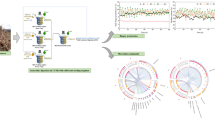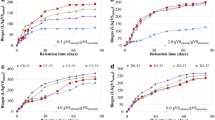Abstract
Different inoculum sources and acclimatization methods result in different substrate adaptation and biodegradability. To increase straw degradation rate, shorten the digester start-up time, and enhance the biogas production, we domesticated anaerobic sludge by adding microcrystalline cellulose (MCC). During acclimatization, the start-up strategies and reactor performance were investigated to analyze changes in feedstock adaption, biodegradability, and methanogen activity. The effect of the domesticated inoculum was evaluated by testing batch un-pretreated corn stover with a dewatered sludge (DS)-domesticated inoculum as a control. The results showed that (1) using MCC as a substrate rapidly improved microorganism biodegradability and adaptation. (2) MCC as domesticated substrate has relatively stable system and high mass conversion, but with low buffer capacity. (3) Macro- and micronutrients should be added for improving the activity of methanogenic and system’s buffer capacity. (4) Using the domesticated inoculums and batch tests to anaerobically digest untreated corn stover yielded rapid biogas production of 292 mL, with an early peak value on the first day. The results indicated that cultivating directional inoculum can efficiently and quickly start-up digester. These investigated results to promote anaerobic digestion of straw for producing biogas speed up the transformation of achievements of biomass solid waste utilization have a positive promoting significance.




Similar content being viewed by others
Abbreviations
- AD:
-
Anaerobic digestion
- CS:
-
Corn stover
- semi-CSTR:
-
Semi-continuous stirred-tank reactor
- C/N ratio:
-
Carbon/nitrogen ratio
- DS:
-
Dewatered sludge
- HRT:
-
Hydraulic retention time
- MCC:
-
Microcrystalline cellulose
- NH4 +-N:
-
Ammonia nitrogen
- OLR:
-
Organic loading rate
- SCOD:
-
Soluble chemical oxygen demand
- TA:
-
Total alkalinity
- TS:
-
Total solid
- VFAs:
-
Total volatile fatty acids
- VS:
-
Volatile solid
References
Li, K., Liu, R. H., & Sun, C. (2016). A review of methane production from agricultural residues in China. Renewable and Sustainable Energy Reviews, 54, 857–865.
Yang, Q., Ju, M. T., & Li, W. Z. (2016). Review of methane production from straws anaerobic digestion. Transactions of the Chinese Society of Agricultural Engineering (Transactions of the CSAE), 32, 232–242.
Pang, Y. Z., Liu, Y. P., Li, X. J., Wang, K. S., & Yuan, H. R. (2008). Improving biodegradability and biogas production of corn stover through sodium hydroxide solid state pretreatment. Energy & Fuels, 22, 2761–2766.
Sawatdeenarunat, C., Surendra, K. C., Takara, D., Oechsner, H., & Khanal, S. K. (2015). Anaerobic digestion of lignocellulosic biomass: challenges and opportunities. Bioresource Technology, 178, 78–186.
Golkowska, K., & Greger, M. (2013). Anaerobic digestion of maize and cellulose under thermophilic and mesophilic conditions—a comparative study. Biomass & Bioenergy, 56, 545–554.
Gu, Y., Chen, X. H., Liu, Z. G., Zhou, X. F., & Zhang, Y. L. (2014). Effect of inoculum sources on the anaerobic digestion of rice straw. Bioresource Technology, 158, 149–155.
Lay, J. J. (2001). Biohydrogen generation by mesophilic anaerobic fermentation of microcrystalline cellulose. Biotechnology and Bioengineering, 74, 280–287.
Chandra, R., Takeuchi, H., & Hasegawa, T. (2012). Methane production from lignocellulosic agricultural crop wastes: a review in context to second generation of biofuel production. Renewable and Sustainable Energy Reviews, 16, 1462–1476.
Li, Y. Q., Feng, L., Zhang, R. H., He, Y. F., Liu, X. Y., Xiao, X., Ma, X. X., Chen, C., & Liu, G. Q. (2013a). Influence of inoculum source and pre-incubation on bio-methane potential of chicken manure and corn stover. Applied Biochemistry and Biotechnology, 171, 117–127.
Thouand, G., Friant, P., Bois, F., Cartier, A., Maul, A., & Block, J. C. (1995). Bacterial inoculum density and probability of para-nitrophenol biodegradability test response. Ecotoxicology and Environmental Safety, 30, 274–282.
Quintero, M., Castro, L., Ortiz, C., Guzman, C., & Escalante, H. (2012). Enhancement of starting up anaerobic digestion of lignocellulosic substrate: fique’s bagasse as an example. Bioresource Technology, 108, 8–13.
Prochazka, J., Mrazek, J., Strosova, L., Fliegerova, K., Zabranska, J., & Dohanyos, M. (2012). Enhanced biogas yield from energy crops with rumen anaerobic fungi. Engineering in Life Sciences, 12, 343–351.
Li, J. J., Zicari, S. M., Cui, Z. J., & Zhang, R. H. (2014). Processing anaerobic sludge for extended storage as anaerobic digester inoculum. Bioresource Technology, 166, 201–210.
Ward, A. J., Hobbs, P. J., Holliman, P. J., & Jones, D. L. (2008). Optimisation of the anaerobic digestion of agricultural resources. Bioresource Technology, 99, 7928–7940.
Bi, S. J., Hong, X. J., Wang, G. X., Li, Y., Gao, Y. M., Yan, L., Wang, Y. J., & Wang, W. D. Effect of domestication on microorganism diversity and anaerobic digestion of food waste. Genetics and Molecular Research, 15(3), gmr.15038417.
Gerardi, M. H., 2003. The Microbiology of Anaerobic Digesters. 1st (ed.). Wiley Interscience.
Chae, K. J., Jang, A., Yim, S. K., & Kim, I. S. (2008). The effects of digestion temperature and temperature shock on the biogas yields from the mesophilic anaerobic digestion of swine manure. Bioresource Technology, 99, 1–6.
Liu, C., Li, H., Zhang, Y., & Chen, Q. (2016a). Characterization of methanogenic activity during high-solids anaerobic digestion of sewage sludge. Biochemical Engineering Journal, 109, 96–100.
APHA. (2005). Standard methods for the examination of water and wastewater (20th ed.). Washington, DC: American Public Health Association.
Rao, P. V., & Baral, S. S. (2011). Experimental design of mixture for the anaerobic co-digestion of sewage sludge. Chemical Engineering Journal, 172, 977–986.
Zhao, H. Y., Li, J., Li, J. J., Yuan, X. F., Piao, R. Z., Zhu, W. B., Li, H. L., Wang, X. F., & Cui, Z. J. (2013). Organic loading rate shock impact on operation and microbial communities in different anaerobic fixed-bed reactors. Bioresource Technology, 140, 211–219.
Michaud, S., Bernet, N., Buffière, P., Roustan, M., & Moletta, R. (2002). Methane yield as a monitoring parameter for the start-up of anaerobic fixed film reactors. Water Research, 36, 1385–1391.
Ennouri, H., Miladi, B., Diaz, S. Z., Güelfo, L. A. F., Solera, R., Hamdi, M., & Bouallagui, H. (2016). Effect of thermal pretreatment on the biogas production and microbial communities balance during anaerobic digestion of urban and industrial waste activated sludge. Bioresource Technology, 214, 184–191.
Serrano, A., Siles, J. A., Martín, M. A., Chica, A. F., Estevez-Pastor, F. S., & Toro-Baptista, E. (2016). Improvement of anaerobic digestion of sewage sludge through microwave pre-treatment. Journal of Environmental Management, 177, 231–239.
Liu, J. B., Yu, D. W., Zhang, J., Yang, M., Wang, Y. W., Wei, Y. S., & Tong, J. (2016b). Rheological properties of sewage sludge during enhanced anaerobic digestion with microwave-H2O2 pretreatment. Water Research, 98, 98–108.
Suárez, A. G., Nielsen, K., Köhler, S., Merencio, D. O., & Reyes, I. P. (2014). Enhancement of anaerobic digestion of microcrystalline cellulose (MCC) using natural micronutrient sources. Brazilian J. Chem. Eng., 31, 393–401.
Kumi, P. J., Henley, A., Shana, A., Wilson, V., & Esteves, S. R. (2016). Volatile fatty acids platform from thermally hydrolysed secondary sewage sludge enhanced through recovered micronutrients from digested sludge. Water Research, 100, 267–276.
Yan, Z. Y., Song, Z. L., Li, D., Yuan, Y. X., Liu, X. F., & Zheng, T. (2015). The effects of initial substrate concentration, C/N ratio, and temperature on solid-state anaerobic digestion from composting rice straw. Bioresource Technology, 177, 266–273.
Pobeheim, H., Munk, B., Lindorfer, H., & Guebitz, G. M. (2011). Impact of nickel and cobalt on biogas production and process stability during semi-continuous anaerobic fermentation of a model substrate for maize silage. Water Research, 45, 781–787.
Demirel, B., & Scherer, P. (2011). Trace element requirements of agricultural biogas digesters during biological conversion of renewable biomass to methane. Biomass & Bioenergy, 35, 992–998.
Zhang, T., Mao, C. L., Zhai, N. N., Wang, X. J., & Yang, G. H. (2015). Influence of initial pH on thermophilic anaerobic co-digestion of swine manure and maize stalk. Waste Management, 35, 119–126.
Li, Y. Q., Zhang, R. H., Liu, G. Q., Chen, C., He, Y. F., & Liu, X. Y. (2013b). Comparison of methane production potential, biodegradability, and kinetics of different organic substrates. Bioresource Technology, 149, 565–569.
Switzenbaum, M. S., Giraldo-Gomez, E., & Hickey, R. F. (1990). Monitoring of the anaerobic methane fermentation process. Enzyme and Microbial Technology, 12, 722–730.
Chen, Y., Cheng, J. J., & Creamer, K. S. (2008). Inhibition of anaerobic digestion process: a review. Bioresource Technology, 99, 4044–4064.
Meng, Y., Li, S., Yuan, H., Zou, D., Liu, Y., Zhu, B., Chufo, A., Jaffar, M., & Li, X. (2015). Evaluating biomethane production from anaerobic digestion mono- and co-digestion of food waste and floatable oil (FO) skimmed from food waste. Bioresource Technology, 185, 7–13.
Fu, S. F., Shi, X. S., Xu, X. H., Wang, C. S., Wang, L., Dai, M., & Guo, R. B. (2015). Secondary thermophilic microaerobic treatment in the anaerobic digestion of corn straw. Bioresource Technology, 186, 321–324.
Acknowledgments
This work was supported by the International Joint Research Projects in the Science & Technology Pillar Program of Tianjin, China (13RCGFSF14300), the Research Projects in the Science & Technology Pillar Program of Tianjin, China (14TXGCCX00012), the Research Projects in the Science & Technology Program of Jinnan District Tianjin, China (2015JNKW0005), the Research Projects in the Science & Technology Pillar Program of Tianjin, China (15JCTPJC63300), and the Ph.D. Candidate Research Innovation Fund of Nankai University.
Author information
Authors and Affiliations
Corresponding author
Electronic Supplementary Material
ESM 1
(DOCX 196 kb)
Rights and permissions
About this article
Cite this article
Yang, Q., Wei, LH., Li, WZ. et al. Effects of Feedstock Sources on Inoculant Acclimatization: Start-up Strategies and Reactor Performance. Appl Biochem Biotechnol 183, 729–743 (2017). https://doi.org/10.1007/s12010-017-2460-1
Received:
Accepted:
Published:
Issue Date:
DOI: https://doi.org/10.1007/s12010-017-2460-1




